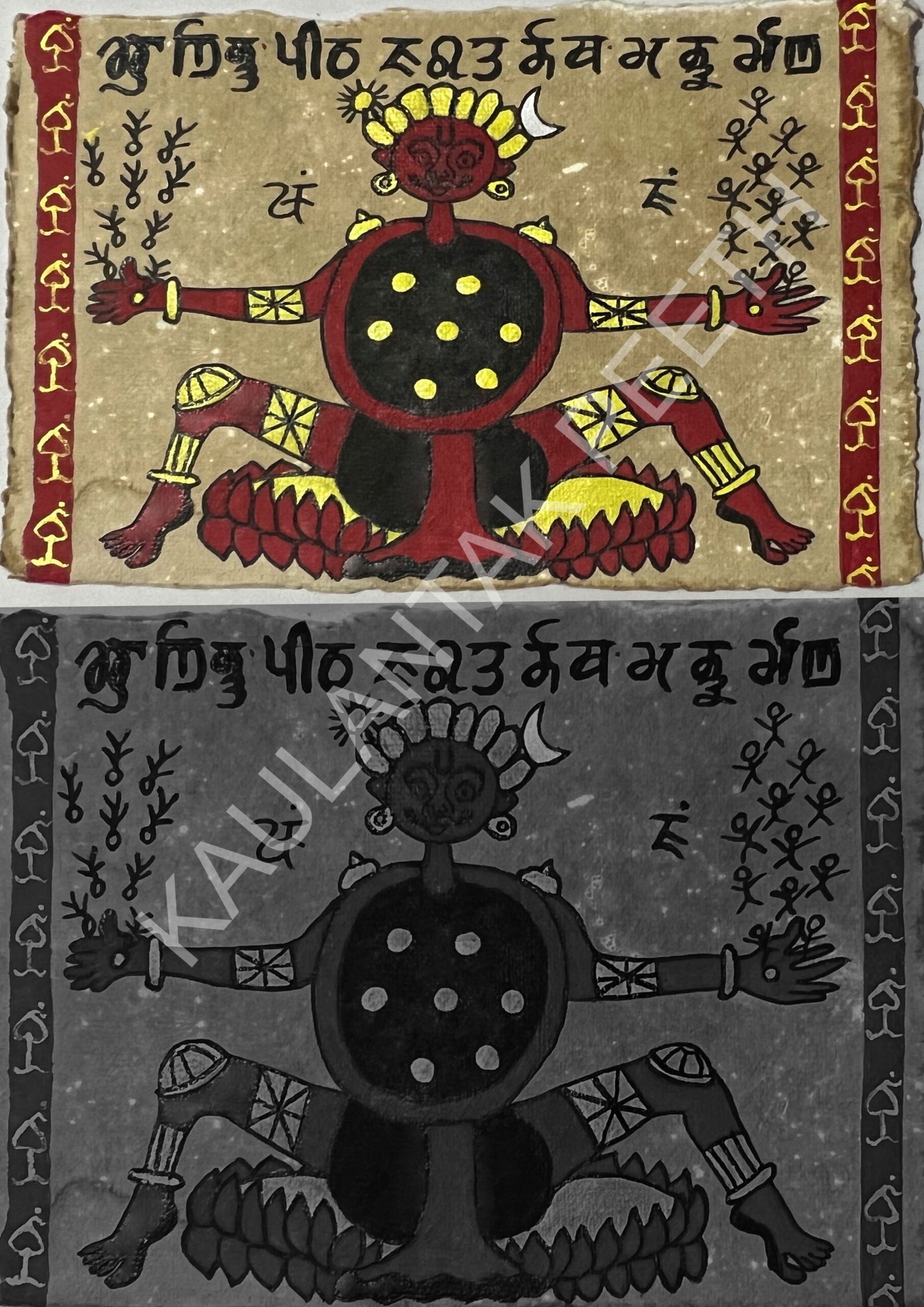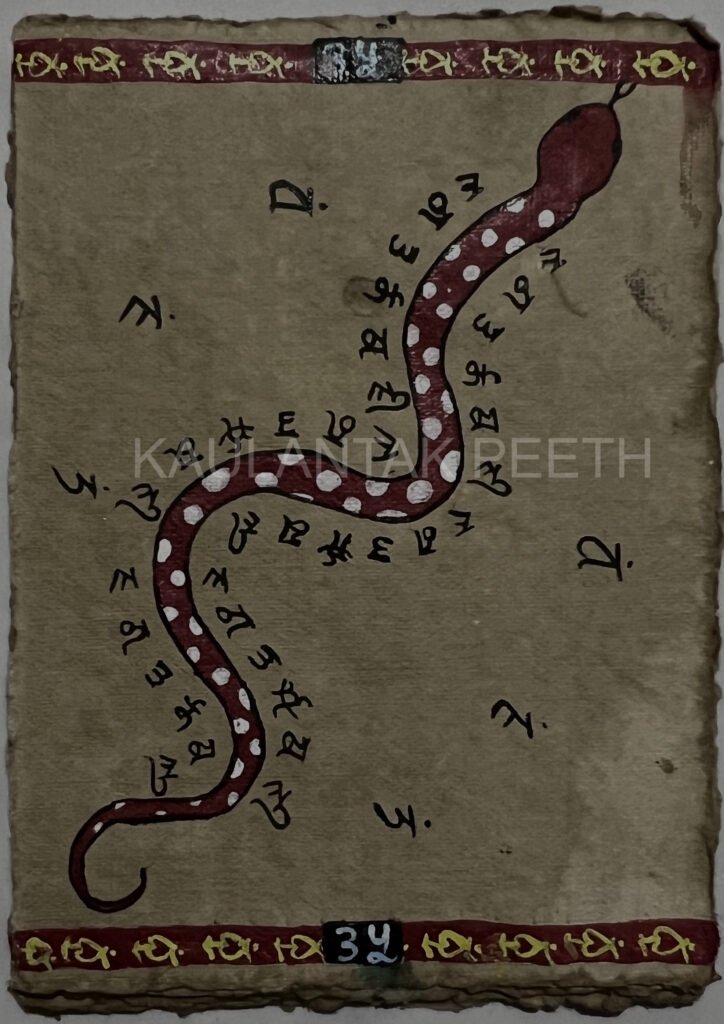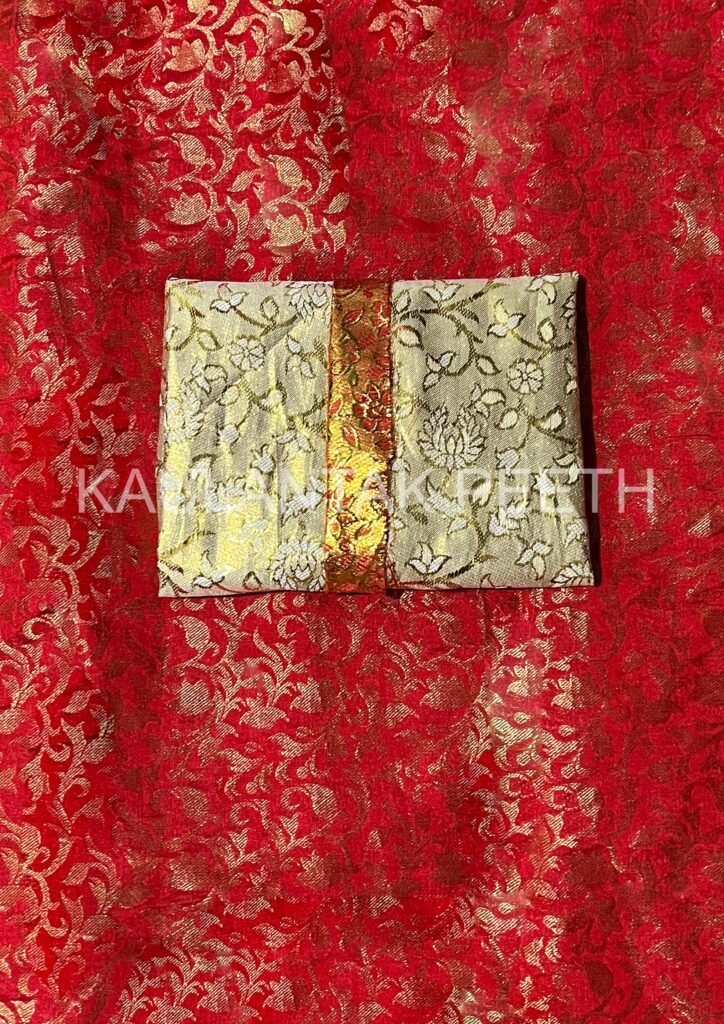The original title of the book ‘Jagat Nath Mantra Maala’ is ‘Kulant Peeth Jagat Nath Mantra Mala’. ‘Jagat Nath Mantra Maala’ is an illustrated manuscript with different mantras. ‘Kulant Peeth Jagat Nath Mantra Mala’ is a combination of five words, ‘Kulant Peeth’ (Kaulantak Peeth), ‘Jagat’ (Sanskrit: जगत) means the world or the world with the living beings, ‘Mantra’ and ‘Mala’ (Sanskrit: माला) which means like garland. Here, ’Mala’ refers to the garland of Mantras. Bhagwan Jagat Nath is popularly and lovingly known as Bhagwan Jagganath in the world. The ‘Jagat Nath Mantra Maala’ is a ‘Granth’ that was written by Mahayogi Shambhu Nath Siddha. Mahayogi Shambhu Nath Siddha was the great devotee of Bhagwan Shiva. Once he was going to the Kailash Mountain for the ‘Darshan’ (to see his Ishta Deva Bhagwan Shiva) of Bhagwan Shiva. He was walking barefoot and was chanting the mantra, ‘Om Namah Shivay’ on the garland of Rudraksha beads while going to Kailash. On the way to Kailash Mountain, he walked through a Himalayan stream. While walking through the stream, he stepped on a stone, which felt extremely soft for a stone. He stopped to see what kind of stone it is.
Mahayogi Shambhu Nath Siddha held the stone in hand. It was a beautiful round, black ‘Shaaligram’ (a black stone which is worshipped as one of the forms of Bhagwan Shri Vishnu and is extremely sacred to Hindus). He saw the unique mark, that the ‘Shaaligram’ has, when he opened the stone. But he found one more popular ‘Vaishnav’ symbol (Ūrdhvapuṇḍra) inside the ‘Shaaligram’. At the back of ‘Shaaligram’ , he found four more sacred symbols of Conch shell, ‘Sudarshan Chakra’, ‘Gada’ (one of the weapons) and Lotus Flower. These are the four most sacred symbols that represent Bhagwan Shri Vishnu. Mahayogi Shambhu Nath Siddha felt unfathomably bad because he felt as if he stepped on Bhagwan Shri Vishnu. He thought that he being the devotee of Bhagwan Shiva, can’t show his face to his ‘Ishta’ when he stepped on Bhagwan Shri Vishnu. He thought that he must repent and do ‘Prayachitta’ before he goes to Kailash Mountain and show his face to Bhagwan Shiva. He began to weep in deep remorse and pain looking at the Kailash Mountain in front of him. After few moments, Bhagwan Shri Vishnu appeared from the ‘Shaligram’ and said to Mahayogi Shambhu Nath Siddha that he has done nothing wrong and he hasn’t sinned. But the Mahayogi could not be consoled by the Bhagwan Shri Vishnu Himself. He kept crying out asking for forgiveness of His ‘Ishta Deva’, Mahadeva. After a while, Mahadeva, Bhagwan Shiva appeared and said to His devotee that when Bhagwan Shri Vishnu is Himself saying that he (Mahayogi Shambhu Nath Siddha) is free of any ‘dosha’ (fault), then it is the truth and Mahadeva said that even He (Mahadeva) do not have any problem with it because it was not his mistake. It was an accident.
It was after this incident that Mahayogi Shambhu Nath Siddha began the lineage of worshipping Bhagwan Shri Vishnu through the ‘Siddha Shaiva Tradition’ by the sacred Mantras dedicated to Bhagwan Shri Vishnu according to the Siddha Shaiva tradition. The Mantras were Tantric in nature complete with Tantric rituals to worship Bhagwan Shri Vishnu. After Mahayogi Shambhu Nath Siddha, many Himalayan Siddhas propagated the tradition of worshipping Bhagwan Shri Vishnu through the Siddha Shaiva Tradition. But Mahayogi Shambhu Nath Siddha was the very first Himalayan Siddha to start it.
Later, many people wrote this ‘Granth’ in the Himalayan Siddha tradition, better known as Siddha Dharm. But it is unknown who wrote it in ‘Kula’ Language. The manuscript mentions only the name of Mahayogi Shambhu Nath Siddha. Although the Mantras are in both Sanskrit and ‘Kula’ language. But who translated it in ‘Kula’ language is unknown and is not mentioned in the ‘Jagat Nath Mantra Maala’ manuscript.
Description
‘Kulant Peeth Jagat Nath Mantra Mala’ manuscript has three parts. The first part contains the eight shlokas known as ‘Aatha’ (in the local language), written in ‘Kula’ language. The second part of the manuscript has a list of Sanskrit ‘Beeja’ Mantras. And the third part has the Yantras and illustrations in Tantric style, followed in Kaulantak Peeth. This is the manuscript of the Siddha Dharm and is written in black and red ink in Tankari script. The ‘Jagat Nath Mantra Maala’ manuscript is written on soft and thick hand-made paper, totaling 18 pages, with the content of the Granth written on both sides of each page.
The dimension of this manuscript is 165 mm by 125 mm. Each text page has four lines of text. The colors of the illustration of the Deity figures were faded. Therefore, the illustrations were retouched to restore the original colour theme. It is of high importance that the illustrations of the manuscript should be retouched when needed to preserve the clarity and original colour of the illustrated sacred figures. In the Siddha Dharma Tradition, manuscripts that are too old and in bad condition (खंडित) are considered inauspicious and are said to be cursed if not restored at the right time.
Contents & Illustrations
This manuscript has three Deity figures, including the Deity figure illustration on the cover page. The Deity Figure on the cover page is of Bhagwan Shri Vishnu in the form of a warrior. Bhagwan Shri Vishnu has big eyes, a moustache, the ‘Ūrdhvapuṇḍra’ Tilak on His forehead, wearing a golden crown with the Sun on the right side of His forehead and a crescent moon on the left side. He is shown wearing warrior dress and sitting with wide legs on an ‘Asan’ of Divine Lotus. His both hands are spread apart with open palms, where the ‘Jeeva Atma’ (referred to as humans here) are disappearing into His right palm and other ‘Jeeva Atma’ are appearing from His left palm.
According to the Kaulantak Nath, head of Kaulantak Peeth (Kulant Peeth), Mahasiddha Ishaputra, the illustration of Bhagwan Shri Vishnu on the cover page of ‘Jagat Nath Mantra Maala’ is depicted in this unique form because here He inspires every person in the world to be a warrior like Him. If you see this illustration carefully, Bhagwan Shri Vishnu is not holding any ‘Shastra’ (weapons) in His hands. Mahasiddha Ishaputra reveals that Bhagwan Shri Vishnu is pointing to the war, the dilemma, inner conflicts, sufferings, and war with ‘agyanta’ (ignorance) that we all face within ourselves, not the war that one fights outside with weapons. Bhagwan Vishnu is giving the message that every human faces two great situations in life: birth and death. Between these two stages, one faces innumerable situations, both tough and good, in life. Human life is full of struggles. So the Great Deity is inspiring everyone to face the situation in life with the zeal of a warrior because He does the same. He faces situations in this Universe with the zeal of a warrior. And we all must do the same.
There are sixteen illustrations of Bhagwan Jagat Nath’s Yantras. In one of the illustrations, Bhagwan Shri Jagat Nath is destroying two demons called ‘Madhu’ and ‘Kaitabh’ on His thighs. The same account has been mentioned in the ‘Markandeya Purana’. In another illustration, He is depicted as flying on His vehicle, Shri Garuda in the night sky, holding a flower in His hands. The manuscript has eight shlokas with two lines in each Shloka, written in ‘Kula’ Language. There are many Mantras of Bhagwan Shri Vishnu in this manuscript in Sanskrit. A ‘Naga Yantra’ has also been illustrated, which describes Bhagwan Shri Shesh Naag. Bhagwan Shri Vishnu rests, like one rests on a bed, on Bhagwan Shri Shesh Naag.
Text & Script
The manuscript on the ‘Jagat Nath Mantra Mala’ has the text which describes the mantra of Bhagwan Shri Jagat Nath with different ‘Beeja Mantras’. The eight shlokas hides the secret of great wisdom about the Universe, Bhagwan Shri Vishnu, about why Bhagwan Shri Jagat Nath is the presiding deity of the Mahasiddhas and much more. These eight shlokas are the special ‘Sutras’ given by Mahayogi Shambhu Nath Siddha. One can understand these ‘Shlokas’ only after a special training given by the Siddha Guru in Siddha Dharm of the Himalayan Siddha Tradition. Each ‘Shloka’ when translated reveals comprehensive wisdom systems of Bhagwan Shri Jagat Nath. Only the Siddha who has the capacity and training of ‘Virata- Anubhuti- Drishti’can explain the complete meaning of these ‘Shlokas’.
The Mantra ‘Mala’ (garland) in this manuscript follows the ‘Matrika Krama’ which refers to Sanskrit ‘Varnamala’ (alphabets). This manuscript is written in ‘Kula Language’ in Tankari script. All the ‘Mantras’ in this manuscript are written in Sanskrit.
Purpose
The purpose of this manuscript is to understand the essence of Bhagwan Shri Jagat Nath. This manuscript is the most concise and yet presents the most comprehensive, wide understanding of what is ‘Jagat’ and who is the ‘Nath’ (the Lord) of this universe according to the Himalayan Siddhas.
Tradition of Preservation
There is a unique tradition to preserve the sacred manuscripts in the library of Kaulantak Peeth (Kulant Peeth). All manuscripts are considered sacred and are worshipped like a Deity is revered.
This manuscript is kept in a dedicated sacred space and is worshipped through a specific worship ritual called the ‘Deva Bhakti’ ritual. The manuscripts in Kaulantak Peeth are worshipped at least once every sixteen days. There is a fixed worship mantra for their worship ritual. But there are unique mantras dedicated to specific manuscripts.
There is a dedicated ‘Granth’ (sacred book) called ‘Granth Kosha Niyamaavali’ in which the ‘Niyamas’ (rules) and disciplines to keep the sacred manuscripts and ‘Granths’ of Kaulantak Peeth are described. Since the main essence of ‘Jagat Nath Mantra Maala’ manuscript is ‘Deva Bhakti’ (devotion), it is wrapped in a yellow cloth. Three ‘Shaligrams’ are kept with this manuscript. According to the discipline, before unwrapping the cloth to see this sacred manuscript, first the three ‘Shaligram’ are worshipped. This particular rule is not written anywhere but has been followed according to the ‘Maukhikh Parampara’ (oral tradition) in Kulant Peeth (Kaulantak Peeth).
Not everyone can conduct these worship rituals. Only the appointed Bhairavs and Bhairavis conduct these rituals with the manuscripts holding the great knowledge that has been passed on in the great lineage of the Himalayan Siddhas of Siddha Dharm.




